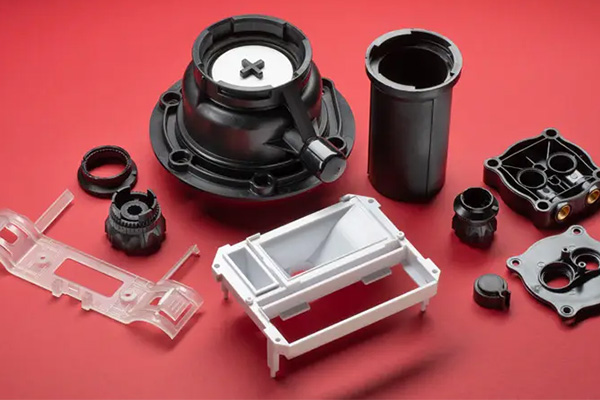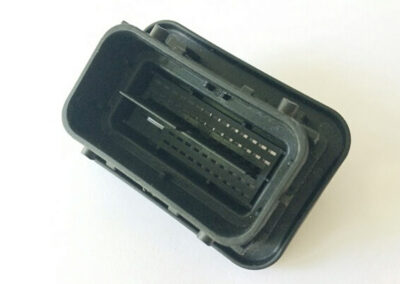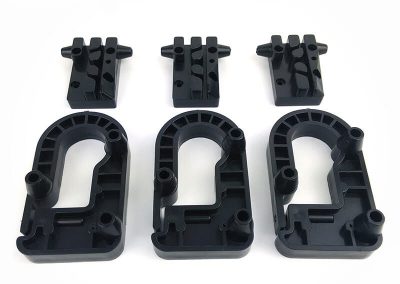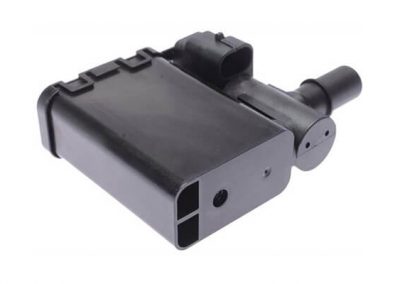Glass Filled Nylon: Complex Nylon (PA) Parts Manufacturing Methods
The strength and mechanical qualities of glass are combined with the adaptability of nylon, a thermoplastic used in CNC machining, injection molding, and 3D printing, to create glass filled nylon, an engineering plastic. Strength, stiffness, and durability are increased when glass fibers are included into the nylon matrix; however, there are certain trade-offs to take into account.
We’ll go over the benefits and drawbacks of Glass Filled nylon in this post so you can decide if it’s right for your parts. With each quote, Sungplastic offers free design for manufacturing (DFM) comments and assists part designers in choosing materials.
Please read the information below if it interests you.

What is Glass Filled Nylon?
Glass Filled nylon, also known as glass-reinforced nylon, is a composite material derived from nylon, a synthetic polyamide sourced from petroleum. Nylon is esteemed for its robustness, resistance to chemicals, and tolerance for varying temperatures. It finds utility in various forms, including textiles as fibers, food packaging films, and manufacturing resins. In the case of Glass Filled nylon, nylon serves as the foundational material, augmented by the incorporation of short glass fibers to enhance its properties.
These short glass fibers play a pivotal role in substantially elevating the strength and resilience of this synthetic plastic. The ratio of glass fibers can vary, contingent upon the desired characteristics of the end product, typically ranging from 10% to 40% by weight. Moreover, Glass Filled nylon is available in diverse grades and may be based on either nylon 6 or nylon 66 formulations. The infusion of glass can be achieved through various methods, such as blending powdered glass particles into nylon resin, integrating small spherical glass beads into nylon powder, or incorporating small glass fibers into nylon pellets or filaments during the extrusion process. Blends like 30% Glass Filled nylon 66 are commonly employed in plastic extrusion applications.
How Strong is Glass Filled Nylon?
The strength of Glass Filled nylon exhibits variability based on the specific formulation of the nylon and the percentage of incorporated glass fibers. It is also influenced by the type and length of the glass fibers, the distribution of these fibers within the nylon matrix, and the overall ratio of fiber to resin. In general, higher proportions of glass fibers yield increased tensile strength, flexural strength, and impact resistance.
Depending on the precise material composition, Glass Filled nylon can exhibit tensile strengths ranging from 50–200 MPa. Flexural strengths may vary from 50–300 MPa or even higher. To ascertain the precise strength characteristics of a particular grade or type, reference to the material’s technical data sheet and testing with sample parts is recommended.
Distinction Between Nylon 12 and Glass Filled Nylon
Nylon 12 and Glass Filled nylon represent two distinct materials, each characterized by unique compositions and properties. Nylon 12, also known as polyamide 12 or PA 12, is an unfilled thermoplastic polymer within the nylon family. This semi-crystalline material offers commendable mechanical strength, notable impact resistance, and excellent resistance to chemical agents.
Nylon 12 also exhibits low moisture absorption, rendering it suitable for deployment in moist or humid environments. It boasts good dimensional stability and possesses low friction properties. Applications for this material span across the automotive, aerospace, electronics, and consumer goods industries.
In contrast, Glass Filled nylon is a composite material resulting from the integration of glass fibers into a nylon matrix, endowing it with enhanced strength and durability in comparison to Nylon 12. Glass Filled nylon is extensively employed in applications necessitating high strength and rigidity, such as automotive components, industrial elements, and consumer products.
Benefits of Glass Filled Nylon
Glass-filled nylon presents several key advantages compared to other materials, particularly unfilled nylon.
Enhanced Strength and Rigidity: Glass-filled nylon boasts superior tensile strength and modulus of elasticity, making it suitable for applications demanding structural integrity and load-bearing capacity.
Improved Dimensional Stability: The inclusion of glass fibers reduces the coefficient of thermal expansion in nylon, enhancing dimensional stability. In practical terms, glass-filled nylon is less susceptible to warping, shrinking, or expanding with temperature fluctuations.
Increased Heat Resistance: The addition of glass fibers elevates the material’s heat distortion temperature (HDT), enabling glass-filled nylon to withstand higher operating temperatures without significant deformation or loss of mechanical properties.
Enhanced Impact Resistance: Glass-filled nylon exhibits greater resilience to impact and improved resistance to cracking and fracturing, rendering it suitable for applications involving dynamic loads.
Good Chemical Resistance: While nylon already possesses commendable chemical resistance, the glass-filled variants of this material can withstand exposure to a wider range of chemicals, oils, and solvents.
Excellent Moldability: Glass-filled nylon is highly moldable, allowing for the creation of intricate shapes and designs. It can be easily injection-molded, supporting cost-effective production of parts.
Electrical Insulation Properties: Similar to unfilled nylon, glass-filled nylon maintains electrical insulating properties, making it a viable option for products containing electrical or electronic components.
Drawbacks of Glass Filled Nylon
Despite its numerous advantages, glass-filled nylon also has some disadvantages that need to be considered.
Increased Abrasiveness: Glass-filled nylon is more abrasive than unfilled nylon, leading to greater wear and tear on 3D printer nozzles, injection molds, and CNC machine tools.
Higher Cost: Glass-filled nylon tends to be more expensive than unfilled nylon due to its enhanced strength and performance, which can make it less cost-effective for certain applications.
Increased Brittleness: Glass-reinforced nylon is generally more brittle than unfilled nylon, making it more susceptible to cracking or fracturing under sudden impacts or high-stress conditions.
Added Weight: Glass-filled nylon can weigh up to 15% more than unfilled nylon, which can be a drawback for applications where lightweight components are a priority.
Anisotropic Properties: Glass-filled nylon displays anisotropic behavior, meaning its mechanical properties can vary based on the direction of loading. The alignment of glass fibers during manufacturing can create variations in strength and stiffness along different axes of the part.
Moisture Absorption: Unlike Nylon 12, glass-filled nylon tends to absorb moisture, potentially leading to dimensional or structural weaknesses in parts exposed to wet or humid environments.
How is Glass Filled Nylon Utilized in Part Manufacturing?
Glass-filled nylon materials find application in part production through various manufacturing techniques, including 3D printing, injection molding, and CNC machining.
3D Printing
Glass-filled nylon can be employed in 3D printing, with three common methods for this purpose:
- Selective Laser Sintering (SLS)
- Multi Jet Fusion (MJF)
- Fused Deposition Modeling (FDM)
Due to the abrasiveness of glass-filled nylon, it is advisable to use hardened steel nozzles for 3D printing with this material. In SLS, the most frequently used nylon grade is PA 12, which can be reinforced with up to 40% glass fibers. Another option is the use of nylon 3200 glass-filled material. In FDM 3D printing, glass-filled nylon filaments, such as nylon 6 (PA 6) with 30% filler, are commonly employed.
CNC Machining
Glass-filled nylon can also be machined, although the material’s abrasiveness poses machining challenges. Like injection molds and 3D printer nozzles, the CNC machining process tends to wear more rapidly when dealing with glass-filled nylon. To achieve optimal results, it is advisable to use carbide or ceramic tools for machining glass-filled polymers. Reducing cutting speed can also help mitigate tool wear.
Injection Molding
Various grades of glass-filled nylon materials are suitable for plastic injection molding. These materials can include glass-filled nylon 66 with fiber reinforcement ratios ranging from 10% to 50%. Given the abrasiveness of glass-filled nylon, it is recommended to use tools made of harder steels in injection molding to prolong the life of the molds.
Applications of Glass-Filled Nylon Parts
Glass-filled nylon parts serve a range of applications in the automotive, electronics, and consumer goods industries due to their electrical insulation properties, resistance to high temperatures, strength, and durability. Despite its higher weight compared to unfilled nylon, glass-filled nylon still offers weight advantages over metal, making it suitable for weight reduction initiatives.
Examples of glass-filled nylon automotive components encompass speedometer gears, engine covers, brake fluid reservoirs, windshield wiper parts, connectors, and wire housings. In the realm of consumer goods, glass-filled nylon is used in appliance manufacturing and various other applications.
Succeeding With Glass Filled Nylon Parts
Glass filled nylon is a flexible material that works well for injection molding, CNC machining and 3D printing. However, while choosing a material, designers must measure the benefits and drawbacks; in addition to strength, other important considerations are cost, weight, and moisture exposure.
When you engage with Sungplastic, you may obtain advice on material selection and design for manufacturing (DFM) support to make sure your components function as required. You can also access experts in all three manufacturing processes.
For you, we can create intricate, high-quality glass filled nylon parts. Reach out to us now!
Get a free quote and design analysis today.
We’ll reply to you within 6 working hours.
We respect your privacy.
+86 139 2927 4777 (WhatsApp, Wechat)



